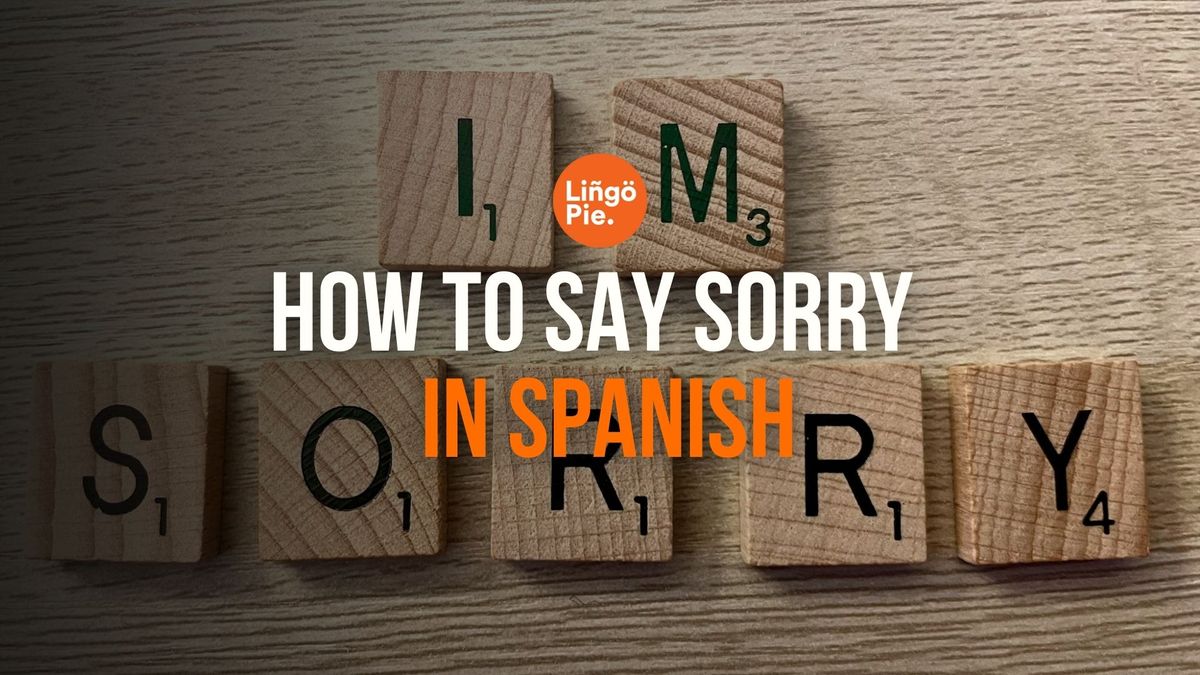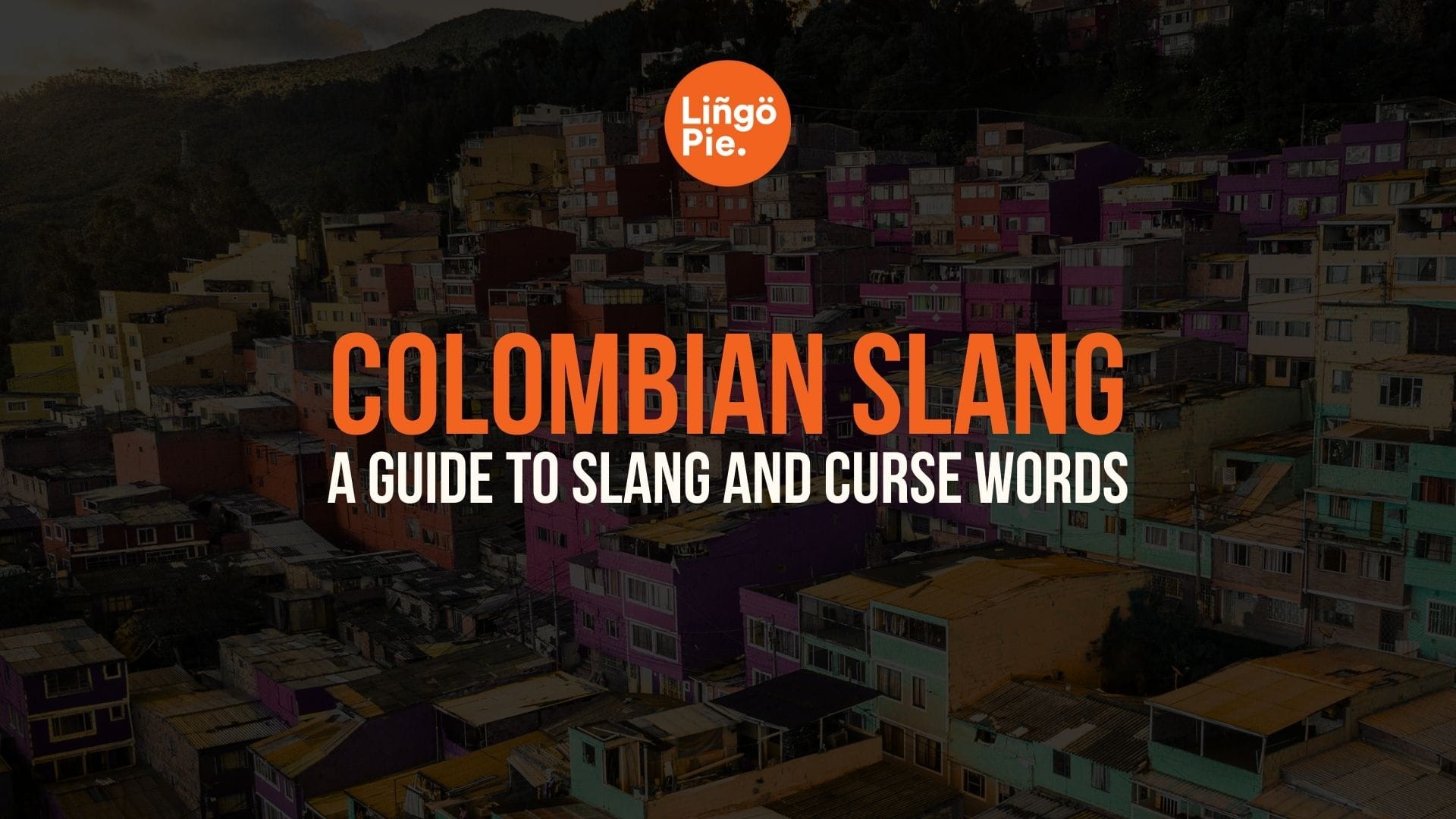Apologizing in Spanish can feel a bit tricky, especially if you're still learning the language. As a native Spanish speaker, I know how important it is to get the apology right—whether you’re speaking to a friend, a colleague, or a stranger. The words you choose and the way you say them can make a big difference in how your apology is received.
In this article, I’ll guide you through the most common ways to apologize in Spanish, explaining their meanings and when to use them. I’ll also share some cultural tips to help you avoid awkward moments and sound more natural. By the end, you’ll be ready to apologize with confidence in any Spanish-speaking context.
- Spanish Prepositions Made Simple: Rules, Tips, and Common Mistakes
- 40 Easy Spanish Greetings You Must Learn in 2025
- Learn Conversational Spanish: Tips & Strategies for 2025
-4 Hacks to Learn a Language With Language Learning Apps

How To Say Sorry In Spanish
The most straightforward way to apologize in Spanish is with "perdón" (pronounced pehr-DOHN), which works in nearly every situation you'll encounter. This versatile word functions as both a casual "sorry" for minor mishaps and a polite "excuse me" when you need someone’s attention.
Common ways to use "perdón" and its variations:
- Perdón — Basic "sorry" or "excuse me" (universal)
- Perdona — Informal "forgive me" (with friends/family)
- Perdone — Formal "pardon me" (with strangers/authorities)
- Perdóname — "Forgive me" (sincere, personal apology)
- Te pido perdón — "I ask for your forgiveness" (serious situations)
For formal interactions, many Spanish speakers prefer "disculpe" over the standard options. This polite form carries a more respectful tone and appears frequently in professional settings, when addressing older individuals, or when seeking help from service workers.
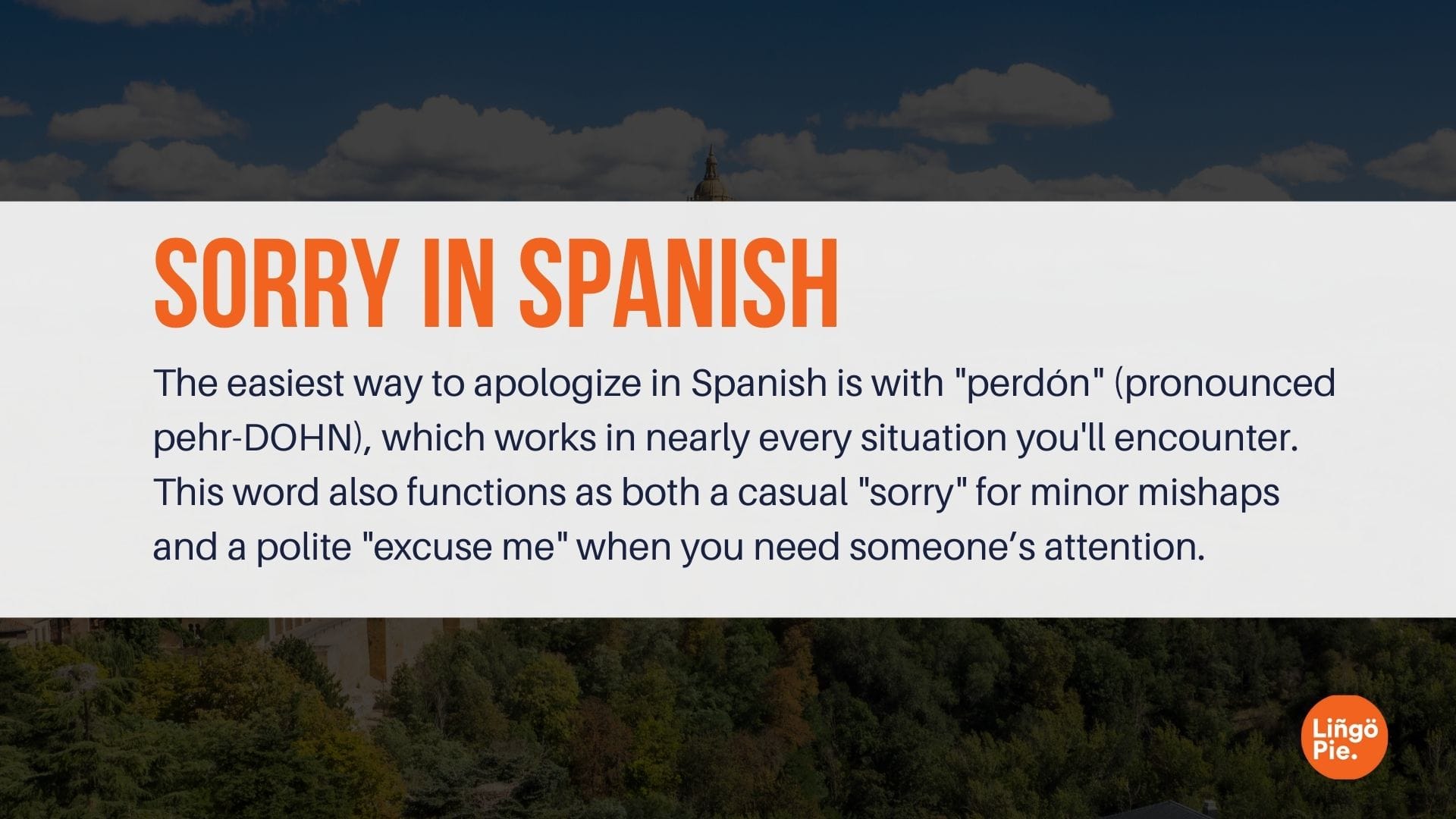
Common Ways To Say Sorry In Spanish
We all make mistakes, and knowing how to apologize properly can make a big difference, especially when learning a new language. An apology shows respect and helps mend situations, but in Spanish, there are several ways to say sorry, depending on the context.
Let’s explore the most common ways to say sorry in Spanish and when to use each one.
1. Perdón
This is probably the most universal apology in Spanish. It translates to “Sorry” in English. If you bump into someone on the street or accidentally interrupt a conversation, "perdón" works in most situations. It’s simple, direct, and can be used both with friends and strangers.
Example:
You step on someone’s foot in a crowded café. You say, “¡perdón!” and offer a quick smile to show you didn’t mean it.
2. Lo Siento
If you need to apologize for a minor mistake, "lo siento" is your go-to phrase. It’s a bit like saying “I'm sorry” in English but with more sincerity.
Example:
You’re trying to get through a crowded room and accidentally bump into someone. You’d say, “lo siento,” as you make your way past them.
3. Disculpa / Disculpe
Here’s where things get a little more formal. "Disculpa" is used when you want to show respect but aren’t necessarily dealing with someone in a formal position. It’s perfect when talking to people you don’t know very well or in a slightly more serious context. If you’re apologizing to someone older or in a position of authority, though, it’s more polite to use "disculpe" (the formal version).
Example:
If you’re trying to get a waiter’s attention at a restaurant, you’d say, “Disculpa, ¿puedo pedir la cuenta?” (Excuse me, can I ask for the check?)
4. Lamento
This one is a bit heavier. "Lamento" translates to “I regret,” and it’s often used in situations where the apology is more serious. If you’ve made a big mistake or need to express deeper remorse, "lamento" might be more appropriate. It’s less about being casual and more about showing genuine regret.
Example:
If you’ve hurt someone’s feelings, you might say, “Lamento mucho lo que dije” (I deeply regret what I said).
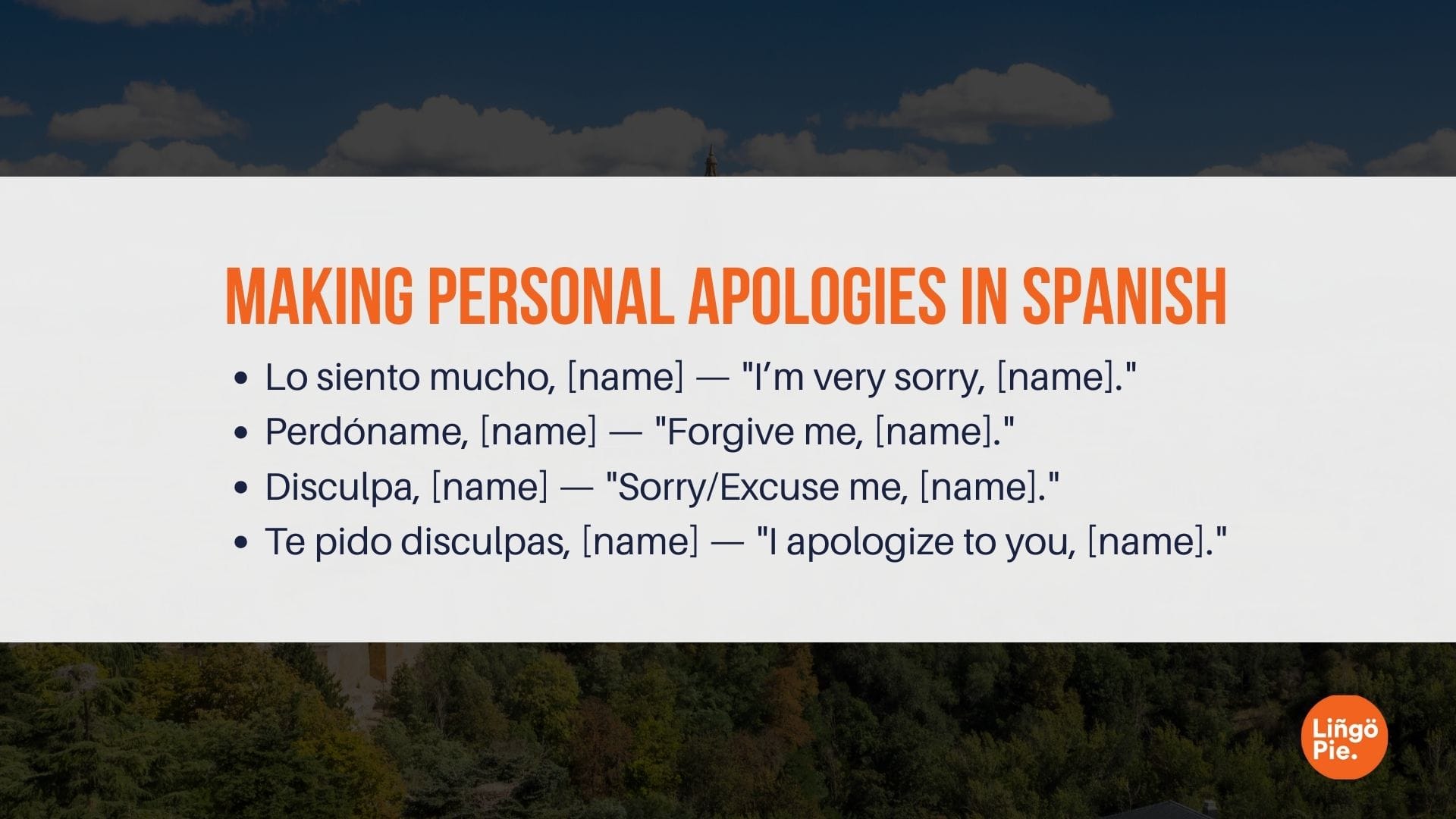
Making Personal Apologies in Spanish
To make an apology more personal in Spanish by including someone's name, it’s common to directly address the person by name or with a term of relationship, combined with the apology phrase.
Here are some ways to say sorry personally:
- Lo siento mucho, [name] — "I’m very sorry, [name]." Example: Lo siento mucho, María.
- Perdóname, [name] — "Forgive me, [name]." Example: Perdóname, Carlos.
- Disculpa, [name] — "Sorry/Excuse me, [name]." Example: Disculpa, Ana.
- Te pido disculpas, [name] — "I apologize to you, [name]." Example: Te pido disculpas, José.
These make the apology feel more direct and heartfelt since you are naming the person you are apologizing to. The tone can be formal or informal depending on your relationship and context, and you can always add intensifiers like "mucho" (very much) to express stronger remorse.
Examples:
- Lo siento mucho, Pedro. No fue mi intención lastimarte. — "I’m very sorry, Pedro. I didn’t mean to hurt you."
- Perdóname, Sofía, por no estar allí. — "Forgive me, Sofía, for not being there."
Personalizing apologies helps communicate sincerity and respect more clearly in Spanish-speaking cultures.
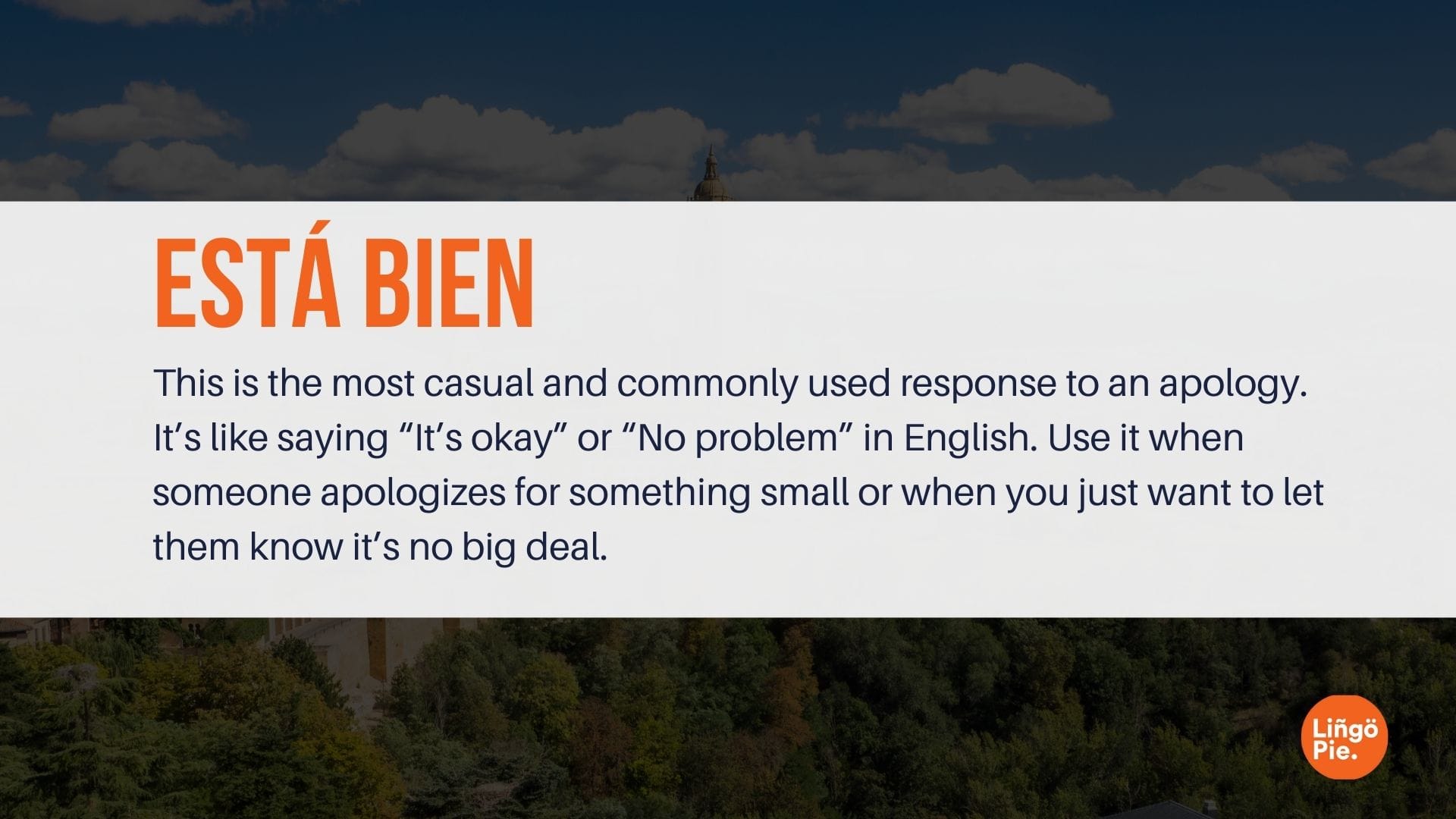
How To Respond To An Apology In Spanish
When someone apologizes to you in Spanish, knowing how to respond is just as important as knowing how to say sorry. Your response can either ease the situation or show understanding. Here are a few common ways to respond, depending on the situation:
1. Está bien – It’s Okay
This is the most casual and commonly used response to an apology. It’s like saying “It’s okay” or “No problem” in English. Use it when someone apologizes for something small or when you just want to let them know it’s no big deal.
Example:
- Person A: “Lo siento por llegar tarde.” (Sorry I’m late.)
- Person B: “Está bien.” (It’s okay.)
2. No pasa nada – No Problem
Another easy-going response, this one literally translates to "Nothing happened" but is commonly used to mean "No problem." It’s great for situations where the apology is for something minor, like spilling a drink or bumping into someone. It shows that you’re not offended and that the issue isn’t a big deal.
Example:
- Person A: “Perdón por el error.” (Sorry for the mistake.)
- Person B: “No pasa nada.” (No problem.)
3. Te perdono – I Forgive You
If someone apologizes and you want to show them you truly forgive them, you can say “Te perdono.” It’s more serious and heartfelt than the casual responses above, and you would use this when you genuinely want to show understanding and reconciliation.
Example:
- Person A: “Perdón, te hice daño.” (Sorry, I hurt you.)
- Person B: “Te perdono.” (I forgive you.)
4. Está todo bien – Everything’s Fine
This is another reassuring response, similar to “Está bien” but with a slightly more positive tone. It's a way to show that you’re not upset and everything is fine between you two. It’s a good middle-ground response when you want to acknowledge the apology without making a big deal out of it.
Example:
- Person A: “Lo siento, me olvidé de tu cumpleaños.” (Sorry, I forgot your birthday.)
- Person B: “Está todo bien.” (Everything’s fine.)
5. No hay de qué – No Need to Thank Me
This one’s a little more unusual, but it’s used when someone says thank you after you’ve forgiven them. It’s a way of saying, “You don’t have to thank me,” and is often used to show that forgiveness or understanding is no trouble.
Example:
- Person A: “Gracias por perdonarme.” (Thank you for forgiving me.)
- Person B: “No hay de qué.” (No need to thank me.)The way you respond to an apology really depends on the situation. Remember, your tone and body language matter, too. A warm, understanding smile or a gentle gesture can go a long way to making your response feel more genuine and reassuring. So, next time someone says sorry in Spanish, you’ll be ready to handle it gracefully!
Idiomatic Spanish Expressions Related to Apologies
Spanish speakers often use colorful idioms to express regret, acknowledge mistakes, or describe the apology process itself. Here are some of our favorites!
- Meter la pata — Literally "to put your foot in it," meaning to make a mistake or blunder.
- Hacer las paces — "To make peace," meaning to reconcile after an argument or dispute.
- Tirar la toalla — "To throw in the towel," surrendering or giving up, sometimes said after apologizing for a failure.
- Bajar la cabeza — "To lower your head," showing humility or shame after wrongdoing.
- Ser un troglodita — "To be a caveman," used humorously to apologize for rude or uncivilized behavior
Learn Spanish Phrases And Apologies With Lingopie
Now you’re equipped with the essential phrases for apologizing in Spanish, whether it’s for a minor mistake or a more serious situation. We’ve covered everything from simple expressions to more formal ones, as well as how to respond when someone apologizes to you. The key takeaway is to match your apology to the situation, considering both the level of formality and the nature of the apology.
If you're looking to dive deeper into Spanish and master everyday conversations, Lingopie is an outstanding resource. With Lingopie, you can practice your Spanish by watching Spanish TV shows and movies and even listening to music—all in Spanish! It’s a fun and effective way to boost your language skills and gain confidence in real-life situations.
FAQs About Saying Sorry In Spanish
Apologizing in a new language can be tricky, especially when you want to make sure you're using the right phrases for different situations. In this section, we’ll answer some of people's most common questions about saying sorry in Spanish.
1. Is There a Difference Between "lo siento" and "lamento"?
Yes, there is a subtle difference. While both express apology, "Lo siento" is widely used to say sorry in any situation. "Lamento," which comes from the verb lamentar (to regret), is slightly more serious and formal. You’d use "Lamento" when you want to express deep regret, like offering condolences or apologizing for something significant.
2. How Do You Apologize if You Don’t Know the Person Well?
When apologizing to someone you don’t know very well, it's always best to be more formal. You’d use "Disculpe" or "Perdone," as these are polite and respectful.
3. Can I Say Sorry in Spanish Without Actually Using the Word “Sorry”?
Yes, in Spanish, there are ways to apologize without saying the word "sorry" directly. You could say "Me equivoqué" (I made a mistake) or "Cometí un error" (I made an error). These phrases express regret for what happened without the need to say "Lo siento."


